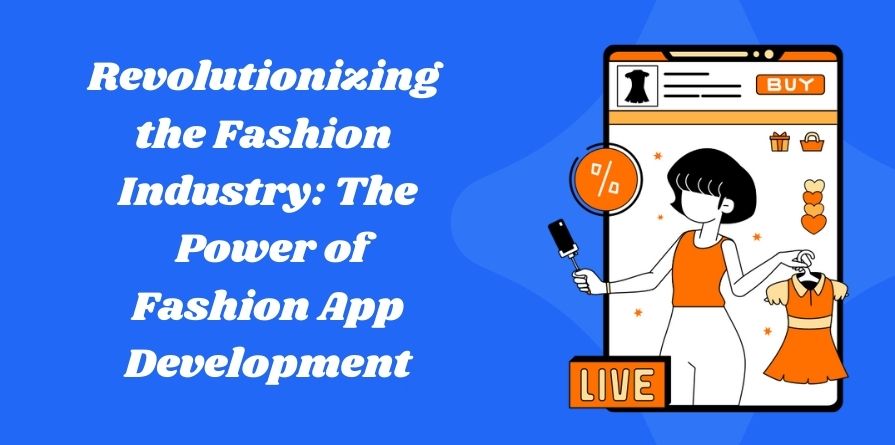Mobile applications have revolutionized the way we engage with the industry. These innovative tools have transformed the fashion landscape by offering a range of features and functionalities that enhance the user experience, connect fashion enthusiasts, and empower fashion businesses. From personalized shopping experiences to virtual try-on capabilities, fashion apps have become essential companions for style-conscious individuals and brands alike. The power of fashion app development and how it has transformed the fashion industry, bringing convenience, inspiration, and a new level of accessibility to fashion enthusiasts worldwide.
Table of Contents
- What Is a Fashion Mobile App?
- Importance of Fashion Application
- Key Features for Fashion App Development
- Types of Fashion Mobile Apps
- Benefits of Fashion Mobile App
- Some Popular Fashion Mobile Apps in 2023
- Conclusion
What Is a Fashion Mobile App?
A fashion mobile application is a software application specifically designed for smartphones and tablets that focuses on delivering fashion-related content, features, and services to users. These apps provide a platform for users to explore fashion trends, discover new styles, browse and purchase clothing and accessories, receive personalized recommendations, and engage with fashion brands and designers. Fashion mobile apps often incorporate visual elements, intuitive interfaces, and interactive features to create an immersive and user-friendly experience, enabling users to stay connected to the latest fashion updates and enhance their shopping and fashion-related activities on the go.
Importance of Fashion Application
Fashion applications play a crucial role in the modern fashion industry, offering a range of benefits and importance to both consumers and fashion businesses. Here are some key reasons why fashion applications are important:
- Enhanced Shopping Experience: Fashion applications provide users with a seamless and convenient way to browse and shop for clothing, accessories, and other fashion items. Users can access a wide range of products, read detailed descriptions, view high-resolution images, and make purchases with just a few taps, enhancing the overall shopping experience.
- Personalization and Recommendations: Fashion apps leverage user data and advanced algorithms to offer personalized recommendations based on individual preferences, purchase history, and browsing behaviour. This level of personalization enhances user engagement, improves the chances of discovering new styles, and boosts customer satisfaction and loyalty.
- Access to Exclusive Content and Offers: Many fashion apps offer exclusive content, such as behind-the-scenes access, fashion shows, and interviews with designers. Additionally, users may receive special promotions, discounts, and early access to sales, creating a sense of exclusivity and incentivizing app usage.
- Social Integration and Community Building: Fashion apps often integrate social media elements, allowing users to share their favourite looks, seek opinions, and engage with other fashion enthusiasts. This social aspect fosters a sense of community and encourages users to participate actively, leading to increased brand awareness and user-generated content.
- Brand Engagement and Loyalty: Fashion apps enable brands to directly engage with their customers and build stronger relationships. Through push notifications, personalized offers, and rewards programs, brands can nurture customer loyalty, encourage repeat purchases, and gather valuable feedback for product improvement.
- Trend Exploration and Inspiration: Fashion apps serve as a source of inspiration, helping users explore the latest fashion trends, styles, and looks. Users can discover new designers, follow fashion influencers, and stay updated on industry news, fostering creativity and facilitating trend exploration.
- Data-Driven Insights: Fashion apps provide businesses with valuable data and insights into customer behaviour, preferences, and purchasing patterns. This data can inform product development, marketing strategies, and inventory management, leading to better decision-making and improved business performance.
- Sustainability and Ethical Fashion: Many fashion apps promote sustainable and ethical fashion by featuring brands that prioritize environmentally friendly practices, fair trade, and ethical sourcing. By connecting users with sustainable fashion options, these apps contribute to a more conscious and responsible fashion industry.
Fashion applications have become essential tools for both consumers and fashion businesses, offering enhanced shopping experiences, personalized recommendations, access to exclusive content, and social engagement. They facilitate trend exploration, promote sustainability, and provide valuable data-driven insights that contribute to the growth and evolution of the fashion industry.
Key Features for Fashion App Development
When developing a fashion app, several key features can enhance the user experience and make the app stand out. Here are some essential features for fashion app development:
- User Registration and Profile: Allow users to create accounts and set up profiles within the app. This feature enables personalized experiences, order tracking, and saved preferences.
- Product Catalog and Search: Include a comprehensive and visually appealing product catalogue with detailed descriptions, images, and filtering options. Implement a robust search functionality that allows users to easily find specific items or browse through categories.
- Virtual Try-On and Augmented Reality (AR): Integrate AR technology to enable users to virtually try on clothing and accessories. This feature enhances the shopping experience by allowing users to see how items will look on them before making a purchase.
- Wishlist and Favorites: Provide users with the ability to save items to their wishlist or mark them as favourites. This feature allows users to save products they are interested in and easily access them later for future reference or purchase.
- Social Media Integration: Allow users to connect their social media accounts to the app, enabling them to share their fashion finds, outfits, and purchases on platforms like Instagram, Facebook, or Twitter. This integration enhances user engagement and promotes brand advocacy.
- Reviews and Ratings: Enable users to provide reviews and ratings for products they have purchased. This feature helps build trust and credibility among users and assists others in making informed purchase decisions.
- Secure Checkout and Payment Gateway: Implement a secure and seamless checkout process, integrating popular payment gateways to ensure safe transactions. Provide multiple payment options, such as credit cards, digital wallets, or PayPal, for user convenience.
- Push Notifications: Send personalized push notifications to users, informing them about new arrivals, discounts, or special offers. This feature keeps users engaged and encourages them to revisit the app.
- Order Tracking and Delivery Updates: Allow users to track their orders in real time and receive updates on the status and estimated delivery time. This feature enhances transparency and customer satisfaction.
- Size and Fit Recommendations: Provide size guides and recommendations to help users choose the right size for clothing items. This feature reduces the likelihood of returns and enhances the overall shopping experience.
By incorporating these key features into a fashion app, you can create a user-friendly, engaging, and personalized experience for your app users, enhancing their shopping journey and fostering brand loyalty.
Types of Fashion Mobile Apps
Fashion mobile apps come in various types, each catering to different aspects of the fashion industry and fulfilling specific user needs. Here are some common types of fashion mobile apps:
- E-Commerce Fashion Apps: These apps focus on providing users with a platform to browse and purchase fashion products online. They feature comprehensive catalogues, secure payment gateways, personalized recommendations, and order tracking. Examples include fashion retailer apps like ASOS, Zara, and Nordstrom.
- Fashion Discovery and Styling Apps: These apps aim to inspire and assist users in discovering new fashion trends, styles, and outfits. They offer curated content, fashion lookbooks, style inspiration, and tools for mix-and-match outfit creation. Users can explore different brands and designers for fashion inspiration. Examples include Polyvore, Pinterest, and Chicisimo.
- Fashion Rental Apps: These apps allow users to rent clothing, accessories, or luxury items for a specific duration instead of purchasing them outright. Users can browse a collection of items, choose what they want to rent, and arrange for delivery and return. Examples include Rent the Runway, Le Tote, or HURR.
- Fashion Social Networking Apps: These apps focus on connecting fashion enthusiasts and creating a community around fashion. Users can share their outfits, follow influencers and fashion bloggers, discover new trends, and engage in discussions. Examples include Instagram, Lookbook, and Pose.
- Fashion News and Magazine Apps: These apps provide users with the latest fashion news, trends, runway coverage, interviews, and editorial content. Users can stay updated on fashion industry happenings, read articles, and access exclusive content from fashion magazines. Examples include Vogue, Elle, and Harper’s Bazaar apps.
- Fashion Brand Apps: Many fashion brands develop their mobile apps to provide a dedicated platform for their customers. These apps offer brand-specific products, promotions, loyalty programs, and exclusive content. Users can directly engage with the brand and access personalized experiences. Examples include Nike, Adidas, and Gucci apps.
- Virtual Styling and Personal Shopping Apps: These apps offer personalized styling services, where users can get recommendations from fashion experts or personal stylists based on their preferences, body type, and occasion. Users can receive personalized advice, shop curated collections, and get fashion tips. Examples include Stitch Fix, Trunk Club, and Stylebook.
These are just a few examples of the different types of fashion mobile apps available. The type of app chosen depends on the specific goals and target audience of the fashion business or the needs and interests of the users.
Benefits of Fashion Mobile App
Fashion mobile apps offer a range of benefits for both users and fashion businesses. Here are some key benefits of fashion mobile apps:
For Users:
- Convenience and Accessibility: Fashion mobile apps provide users with the convenience of browsing and shopping for fashion items anytime and anywhere, directly from their smartphones or tablets. Users can easily explore collections, make purchases, and access fashion-related content with just a few taps.
- Personalized Shopping Experience: Fashion apps leverage user data and preferences to offer personalized recommendations, creating a tailored shopping experience for each user. Users can discover new styles, receive outfit suggestions, and find products that align with their tastes and preferences.
- Enhanced Visual Experience: Fashion apps often feature high-quality images, videos, and interactive elements that showcase clothing, accessories, and fashion trends in a visually appealing manner. Users can get a detailed view of products, zoom in for closer inspection, and even utilize virtual try-on features to see how items would look on them.
- Fashion Inspiration and Trend Exploration: Fashion apps provide users with a constant source of fashion inspiration, allowing them to explore the latest trends, styles, and looks. Users can access fashion blogs, articles, and curated content, helping them stay up-to-date with the ever-evolving fashion industry.
- Seamless Social Sharing: Fashion apps often integrate social media elements, enabling users to easily share their favourite fashion finds, outfits, and purchases on platforms like Instagram, Facebook, or Twitter. This sharing capability allows users to engage with their social networks, seek opinions, and become part of a fashion-focused community.
For Fashion Businesses:
- Increased Brand Reach and Visibility: A fashion mobile app can significantly expand the brand’s reach by providing access to a wider audience base. With millions of smartphone users worldwide, a well-designed fashion app can increase brand visibility and awareness, attracting new customers and fostering brand loyalty.
- Direct Customer Engagement: Fashion apps enable direct interaction and engagement with customers, creating opportunities for brands to build stronger relationships and gather valuable feedback. Push notifications, personalized offers, and loyalty programs within the app can help increase customer engagement and foster brand loyalty.
- Data-Driven Insights: Fashion apps provide businesses with access to valuable user data and analytics. By analyzing customer behaviour, preferences, and purchasing patterns, brands can gain insights into market trends, customer demands, and the effectiveness of marketing strategies. This data-driven approach helps businesses make informed decisions, optimize their offerings, and improve overall operational efficiency.
- Increased Sales and Conversion Rates: Fashion apps can significantly boost sales and conversion rates by providing a seamless and user-friendly shopping experience. The convenience of browsing and purchasing within the app, combined with personalized recommendations and exclusive offers, enhances customer satisfaction and encourages repeat purchases.
- Competitive Advantage: In an increasingly digital and mobile-driven world, having a well-developed fashion app can give businesses a competitive edge. By embracing mobile technology and offering a superior app experience, fashion brands can differentiate themselves from competitors and attract tech-savvy customers who prefer the convenience and functionality of mobile apps.
Fashion mobile apps offer a range of benefits that enhance the user experience, drive customer engagement, and provide valuable insights for fashion businesses. By leveraging the power of mobile technology, fashion brands can strengthen their presence in the market, foster customer loyalty, and stay ahead of the competition. If you want to build fashion mobile apps then you should go with only highly reputed mobile app development companies.
Some Popular Fashion Mobile Apps in 2023
- ASOS: ASOS is a popular fashion app known for its extensive collection of clothing, accessories, and beauty products. It offers a wide range of brands and provides personalized recommendations based on user preferences.
- Zara: Zara’s app allows users to browse and shop the latest fashion trends from the renowned fast-fashion brand. It features a user-friendly interface, detailed product information, and a seamless shopping experience.
- H&M: H&M’s app provides users with access to their fashion collections, allowing them to explore and purchase clothing, accessories, and home decor items. The app also offers exclusive deals and discounts for app users.
- Polyvore: Polyvore is a fashion discovery and styling app that allows users to create outfits, browse and shop for fashion items, and get style inspiration from a community of fashion enthusiasts. Users can mix and match clothing items and create personalized looks.
- Vinted: Vinted is a fashion marketplace app focused on buying and selling secondhand clothing and accessories. Users can list their pre-loved items, shop for unique finds, and engage in a community of fashion-conscious individuals.
- Rent the Runway: Rent the Runway is a fashion rental app that enables users to rent designer clothing and accessories for special occasions. It offers a wide selection of high-end fashion items, allowing users to access luxury fashion without the need for a permanent purchase.
- Depop: Depop is a popular fashion marketplace app that combines elements of social media and e-commerce. Users can buy and sell secondhand clothing, vintage items, and unique fashion pieces while engaging with a community of fashion enthusiasts.
Conclusion
Fashion app development has brought about a paradigm shift in the fashion industry, offering users unparalleled convenience, personalization, and accessibility. These apps have empowered fashion enthusiasts to explore, shop, and engage with fashion in new and exciting ways while providing valuable insights and opportunities for fashion businesses to connect with their target audience. As technology continues to advance, the impact of fashion apps will only continue to grow, shaping the future of fashion consumption and redefining the boundaries of creativity and innovation. Whether it’s browsing the latest trends, virtually trying on outfits, or sharing fashion inspiration with the world, fashion apps have become indispensable tools that have revolutionized the way we experience and interact with the world of fashion.



